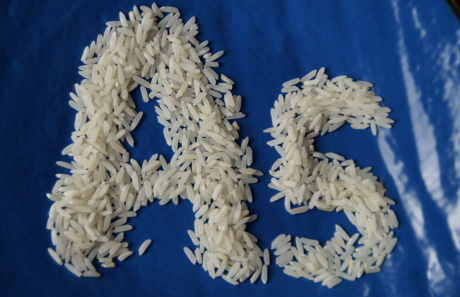The Food and Drug Administration announced recently the availability of a final guidance for industry entitled “Inorganic Arsenic in Rice Cereals for Infants" defining an Action Level of 100 ppb.
Background:
Arsenic is a naturally occurring element in the environment that can enter the food supply through soil, water or air. Arsenic levels in the environment are generally low but can vary depending on the natural geological situation. Local arsenic levels can also be enhanced by human activities releasing the element to the environment, such as mining, fracking, coal-burning or use of arsenic containing pesticides. Being present in the soil and/or irrigation water, arsenic is taken up by plants and ends up in their consumed parts. While cereals made from wheat and other grains sometimes contain arsenic, rice
cereals can be especially high because rice absorbs up to 10 times more
of the heavy metal from the soil than other grains do (see the EVISA News below).

Arsenic is found in both inorganic and organic forms (together referred
to as total arsenic), and inorganic arsenic is generally considered more
toxic than organic arsenic. Consumption of inorganic arsenic has been
associated with cancer, skin lesions, cardiovascular disease and
diabetes in humans, as well as adverse pregnancy outcomes and
neurodevelopmental toxicity as adverse health effects.
In 2012 the NGO "Consumer Reports" first called attention to the dangerous presence of inorganic arsenic in infant cereal rice. In testing about 200 samples of rice products, they had found that some infant rice cereals, which are often a baby’s first solid
food, had levels of inorganic arsenic at least five times more than has
been found in alternatives such as oatmeal.
FDA guidance on inorganic arsenic in rice cereals for infants:
The FDA is informing on their website "Arsenic in Food and Dietary Supplements" that "it is not possible to remove arsenic entirely from the environment or food supply". The FDA, therefore, seeks to limit consumer exposure to arsenic to the greatest extent feasible. After evaluation of the health risks associated with infant exposure to
inorganic arsenic, as well as the testing results of
commercially-available products, the FDA has concluded that good
manufacturing practices can reliably produce rice cereals with no more
than 100 µg/kg (ppb) inorganic arsenic. Four years after issuing a draft guidance, FDA announced in August the availability of the final guidance for industry entitled "“Inorganic Arsenic in Rice Cereals for Infants: Action Level.” The final guidance approves the action level of 100 µg/kg inorganic arsenic that was defined already in the draft document.
What does this mean for companies manufacturing or selling rice-based infant cereals?
FDA’s guidance do not establish legally enforceable responsibilities and therefore call for cooperation from the rice and baby food industry to establish the safety of infant rice cereals. The guidance rather represents the agency's current thinking about this topic and is intended to encourage manufacturers to reduce levels of inorganic arsenic in their products. FDA is thinking that it is possible to reduce dietary exposure to inorganic arsenic from infant rice cereals through industry’s use of current good manufacturing practices, in particular selection of sources of rice or rice-derived ingredients with lower inorganic arsenic levels and testing this incoming rice and rice-derived ingredients. The agency also announced that it is intended to analyse samples of infant rice cereals for total arsenic, and to speciate samples containing more than 100 μg/kg or 100 ppb total arsenic to determine inorganic arsenic levels. The agency concludes that any finished products containing greater than 100 ppb inorganic arsenic
may be considered adulterated under section 402(a)(1) of the FD&C
Act and potentially subject to enforcement action by the FDA.
 Related Information
Related Information U.S. FDA: Arsenic in food and Dietary Supplements
U.S. FDA: Arsenic in food and Dietary Supplements
 Related EVISA News
Related EVISA News (newest first):
 November 14, 2013: Arsenic Speciation in Rice Cereals for Infants
November 14, 2013: Arsenic Speciation in Rice Cereals for Infants  May 15, 2013: Arsenic species in rice: Origin, uptake and geographical variation
May 15, 2013: Arsenic species in rice: Origin, uptake and geographical variation  February 15, 2013: JRC-IRMM has released ERM-BC211 certified rice reference material for arsenic speciation analysis
February 15, 2013: JRC-IRMM has released ERM-BC211 certified rice reference material for arsenic speciation analysis September 21, 2012: Arsenic in Rice : First results from the U.S. Food and Drug Administration
September 21, 2012: Arsenic in Rice : First results from the U.S. Food and Drug Administration
J
anuary 4, 2011: Arsenic species in rice: Call for analytical laboratories  May 19, 2010: China: Inorganic Arsenic in Rice - An Underestimated Health Threat ?
May 19, 2010: China: Inorganic Arsenic in Rice - An Underestimated Health Threat ?  December 4, 2009: EFSA: Scientific Opinion on Arsenic in Food
December 4, 2009: EFSA: Scientific Opinion on Arsenic in Food  May 26, 2009: UK Food Standards Agency releases research on arsenic in rice milk
May 26, 2009: UK Food Standards Agency releases research on arsenic in rice milk July 18, 2008: Experts detail how rice absorbs arsenic from the soil
July 18, 2008: Experts detail how rice absorbs arsenic from the soil  March 15, 2008: Arsenic in rice milk exceeds EU and US drinking water standards
March 15, 2008: Arsenic in rice milk exceeds EU and US drinking water standards
 February 15, 2008:
Arsenic speciation in rice: a question of the rice plant species
February 15, 2008:
Arsenic speciation in rice: a question of the rice plant species March 7, 2007: Elevated Arsenic Levels Found In Rice Grown In South Central States of the USA
March 7, 2007: Elevated Arsenic Levels Found In Rice Grown In South Central States of the USA  September 7, 2006: New Agilent HPLC column for routine
determination of arsenic species in human urine by HPLC-ICP-MS
September 7, 2006: New Agilent HPLC column for routine
determination of arsenic species in human urine by HPLC-ICP-MSlast time modified: September 19, 2024